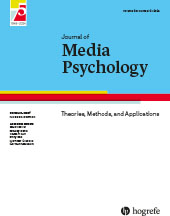Abstract
Zusammenfassung. Der Beitrag diskutiert zunächst theoretisch und methodisch die Forschungslage zu Framing-Effekten. Dabei wird deutlich, dass bislang fast immer die Wirkung ‘formaler Frames‘ (z.B. episodischer vs. thematischer Frame) untersucht wurde. In einem Experiment untersuchten wir die Wirkung ‘inhaltlicher Frames‘ (z.B. Menschenrechts- vs. Wirtschafts-Frame). Das einfaktorielle Design mit Messwiederholung (je zwei Frames für zwei Themen) brachte unter anderem folgende Befunde: Die Medien-Frames beeinflussten die Kognitionen der Proband/inn/en, aber kaum deren Meinungen und Handlungsbereitschaft.
Abstract. The article discusses the framing effects approach, both in theoretical and methodological respect. This discussion proves that almost all studies only examine effects of ‘formal frames’ (e.g., episodical vs. thematical frame). In an experiment we studied the effects of ‘content-related frames’ (e.g., human rights vs. economics frame). The one factorial design with repeated measurement (two frames each for two issues) proved that media frames influenced subjects’ cognitions, but seldomly their opinions and readiness for action.
Literatur
(1973). Schema theory: An information processing model of perception and cognition. American Political Review, 67, 1248– 1266
(1991). Schema-Theorie - ein brauchbarer Ansatz in der Wirkungsforschung?. Publizistik, 36, 285– 297
(1997). Spiral of cynicism. The press and the public good . New York, Oxford: Oxford University Press
(2003). Empirische Sozialforschung. Grundlagen, Methoden, Anwendungen (10. Aufl.). Reinbek bei Hamburg: Rowohlt
(1988). News as discourse . Hillsdale, NJ: Lawrence Erlbaum
(1993). Framing: Towards clarification of a fractured paradigm. Journal of Communication, 43, 51– 58
(1975). Belief, attitude, intention and behavior. An introduction to theory and research . Reading, MA: Addison-Wesley
(1991). Social cognition (2nd ed.). New York: McGraw-Hill
(1989). Media discourse and public opinion on nuclear power: A constructionist approach. American Journal of Sociology, 95, 1– 37
(1980). The whole world is watching: Mass media in the making and unmaking of the new left . Berkeley, CA: University of California Press
(1991). Is anyone responsible? How television frames political issues . Chicago, London: University of Chicago Press
(1987). News that matters: Television and American opinion . Chicago, London: University of Chicago Press
(1989). Mental models. In M. I. Posner (Ed.), Foundations of cognitive science (pp. 469-499). Cambridge, MA: MIT Press.
(1991). Opinion formation in mediated conflicts and crisis: A theory of cognitive-affective media effects. International Journal of Public Opinion Research, 3, 132– 156
(1977). Human information processing. An introduction to psychology . New York: Academic Press
(1986). Parallel distributed processing (Vol. 2: Psychological and biological models). Cambridge, MA: MIT Press
(1997). Candidate images in Spanish elections: Second-level agenda-setting effects. Journalims & Mass Communication Quarterly, 74, 703– 717
(1993). Auf dem Weg in die “Bewegungsgesellschaft“?. Soziale Welt, 44, 305– 326
(1997). Toward a psychology of framing effects. Political Behavior, 19, 221– 246
(1992). Common knowledge. News and the construction of political meaning . Chicago, London: University of Chicago Press
(1989). Öffentliche Meinung. Die Entdeckung der Schweigespirale . Frankfurt/M., Berlin: Ullstein
(1995). Presidential support during the Iran-contra-affair: People’s reasoning process and media influence. Communication Research, 24, 207– 236
(1997). News values and public opinion: A theoretical account of media priming and framing. In G. Barnett & F. J. Boster (Eds.), Progress in the communication sciences (pp. 173-212). Greenwich, CT: Ablex
(1997). Switching trains of thought: The impact of news frames on reader’s cognitive responses. Communication Research, 24, 481– 506
(2001). Prologue - Framing public life: A bridging model for media research. In S. D. Reese, O. H. Gandy & A. E. Grant (Eds.), Framing public life. Perspectives on media and our understanding of the social world (pp. 7-31). Mahwah, NJ, London: Lawrence Erlbaum
(1997). Strategy and issue frames in election campaign coverage: A social cognitive account of framing effects. Journal of Communication, 47, 26– 48
(1978). Accretion, tuning, and restructuring: Three models of learning. In J. W. Cotton & R. L. Klatzky (Eds.), Semantic factors in cognition (pp. 37-53). Hillsdale, NJ: Lawrence Erlbaum
(2002). Medienwirkungsforschung (2. Aufl.). Tübingen: Mohr Siebeck
(1999). (Visual) Media Framing und Politik. Zur Brauchbarkeit des Framing-Ansatzes im Kontext (visuell) vermittelter politischer Kommunikation und Meinungsbildung. In W. Hofmann (Hrsg.), Die Sichtbarkeit der Macht. Theoretische und empirische Untersuchungen zur visuellen Politik (S. 91-107). Baden-Baden: Nomos
(2003). Frames - Framing - Framing-Efekte. Theoretische und methodische Grundlegung sowie empirische Befunde zur Nachrichtenproduktion . Wiesbaden: Westdeutscher Verlag
(2004). Framing-Effekte auf dem Prüfstand. Eine theoretische, methodische und empirische Auseinandersetzung mit der Wirkungsperspektive des Framing-Ansatzes. Medien & Kommunikationswissenschaft, 52, 30– 55
(2001). The effects of value-framing on political judgment and reasoning. In S. D. Reese, O. H. Gandy & A. E. Grant (Eds.), Framing public life. Perspectives on media and our understanding of the social world (pp. 227-243). Mahwah, NJ, London: Lawrence Erlbaum
(1988). Ideology, frame resonance, and participant mobilization. In B. Klandermans, H. Kriesi & S. Tarrow (Eds.), International social movement research (Vol. 1: From structure to action: Comparing social movement research across cultures, pp. 197-217). Greenwich, CT: JAI Press
(1997). Exploring the media’s roles in defining reality: From issue-agenda-setting to attribute-agenda-setting. In M. McCombs, D. L. Shaw & D. Weaver (Eds.), Communication and democracy. Exploring the intellectual frontiers in agenda-setting-theory (pp. 15-27). Mahawah, NJ, London: Lawrence Erlbaum
(1999). The effects of news frames on readers’ thoughts and recall. Communication Research, 26, 550– 569
(1992). Schema theory and measurement in mass communication research: Theoretical and methodological issues in news information processing. In S. A. Deetz (Ed.), Communication Yearbook 15 (pp. 115-145). Newbury Park, London, New Delhi: Sage
(1978). The variable nature of media influence. In B. D. Rubin (Ed.), Communication Yearbook 2 (pp. 225-245). New Brunswick, NJ: Transaction Books



